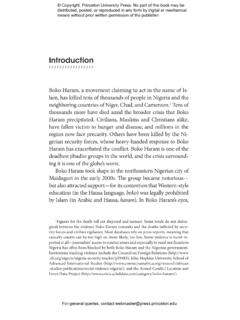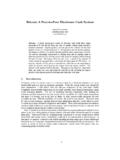Transcription of 2020 1500+ PRACTICE QUESTIONS ON INDIAN HISTORY
1 2020 1500+ PRACTICE QUESTIONS ON INDIAN HISTORY Get Free Study Materials & Previous Year Papers @ Us On Telegram - + PRACTICE QUESTIONS ON INDIAN HISTORY QUESTIONS WITH ANSWERS ANCIENT INDIA : QUESTIONS WITH ANSWERS 1. Which of the following Vedas deals with magic spells and witchcraft? (a) Rigveda (b) Samaveda (c) Yajurveda (d) Atharvaveda Ans: (d) 2. The later Vedic Age means the age of the compilation of (a) Samhitas (b) Brahmanas (c) Aranyakas (d) All the above Ans: (d) 3. The Vedic religion along with its Later (Vedic) developments is actually known as Get Free Study Materials & Previous Year Papers @ Us On Telegram - (a) Hinduism (b) Brahmanism (c) Bhagavatism (d) Vedic Dharma Ans: (b) 4.
2 The Vedic Aryans first settled in the region of (a) Central India (b) Gangetic Doab (c) Saptasindhu (d) Kashmir and Punjab Ans: (c) 5. Which of the following contains the famous Gayatrimantra? (a) Rigveda (b) Samaveda (c) Kathopanishad (d) Aitareya Brahmana Ans: (a) 6. The famous Gayatrimantra is addressed to (a) Indra (b) Varuna (c) Pashupati (d) Savita Free Study Materials & Previous Year Papers @ Us On Telegram - : (d) 7. Two highest ,gods in the Vedic religion were (a) Agni and Savitri (b) Vishnu and Mitra (c) Indra and Varuna (d) Surya and Pushan Ans: (c) 8. Division of the Vedic society into four classes is clearly mentioned in the (a) Yajurveda (b) Purusa-sukta of Rigveda (c) Upanishads (d) Shatapatha Brahmana Ans: (b) 9.
3 This Vedic God was 'a breaker of the forts' and also a 'war god' (a) Indra (b) Yama (c) Marut (d) Varuna Ans: (a) 10. The Harappan or Indus Valley Civilisation flourished during the ____ age. (a) Megalithic (b) Paleolithic (c) Neolithic Free Study Materials & Previous Year Papers @ Us On Telegram - (d) Chalcolithic Ans: (d) 11. The first metal to be extensively used by the people in India was (a) Bronze (b) Copper (c) Iron (d) Tin Ans: (b) 12. Which of the following civilisations is net associated with the Harappan Civilisation? (a) Mesopotamian (b) Egyptian (c) Sumerian (d) Chinese Ans: (d) 13.
4 Of the following scholars who was the first to discover the traces of the Harappan Civilisation? (a) Sir John Marshall Free Study Materials & Previous Year Papers @ Us On Telegram - (b) RD Banerji (c) A Cunningham (d) Daya Ram Sahani Ans: (d) 14. The Harappan Civilisation achieved far greater advancement than Sumer, Elam etc. on account of its (a) town planning (b) metal working (c) weights and measures (d) seals and figures Ans: (a) 15. The town planning in the Harappan Civilisation was inspired by a regard for (a) beauty and utility (b) uniformity (c) sanitation and public health (d) demographic factor Ans: (c) 16.
5 The Indus or Harappan Civilisation is distinguished from the other contemporary civilisations by its (a) town planning (b) underground drainage system Free Study Materials & Previous Year Papers @ Us On Telegram - (c) uniformity of weights and measures (d) large agricultural surplus Ans: (b) 17. Match the location of the following Harappan sites: List-1 List-2 (Sites) (States) A. Ropar (i) Uttar Pradesh B. Alamgirpur (ii) Punjab C. Kalibangan (iii) Gujarat D. Dholavira (iv) Rajasthan E. Banawali (v) Haryana Codes: A B C D E (a) ii i iv iii v (b) i ii iii iv v (c) ii i iii iv v (d) ii iii I v iv Ans: (a) 18.
6 The date of the Harappan Civilisation (2300-1750 BC) has been fixed on the basis of (a) Pottery design (b) Stratification (c) Aryan invasion (d) Radio Carbon-14 dating Free Study Materials & Previous Year Papers @ Us On Telegram - : (d) 19. Most of the large Harappan towns had for fortifications which served the purpose of (a) safety from robbers (b) protection against cattle raiders (c) protection against floods (d) All the above Ans: (d) 20. Cereal(s) grown by the people of the Harappan Civilisation was/were (a) Wheat (b) Rice (c) Millet (d) All the above Ans: (d) 21. The utensils of the Indus Valley people were mainly made of (a) clay (b) copper (c) bronze (d) brass Ans: (a) 22.
7 Which of the following metals was not known to the Indus valley people? (a) gold (b) silver (c) copper (d) iron Free Study Materials & Previous Year Papers @ Us On Telegram - Ans: (d) 23. Which of the following objects was not worshipped by the Indus valley people (a) Mother Goddess (b) Pashupati Shiva (c) Trees such as Peepal and Acacia (d) Trimurti Ans: (d) 24. At which of the following Harappan sites has a supposed dockyard been found? (a) Kalibangan (b) Lothal (c) Suktagendor (d) Sotka Koli Ans: (b) 25. The economy of the Indus Valley people was based on? (a) Agriculture (b) Trade and Commerce (c) Crafts (d) All the above Ans: (d) 26.
8 The Harappan Civilisation declined as a result of (a) Aryan invasion Free Study Materials & Previous Year Papers @ Us On Telegram - (b) Decline in foreign trade (c) Ecological factors (d) Not definitely known factors Ans: (d) 27. The most common animal figure found at all the Harappan sites is (a) unihorn bull (b) cow (c) bull (d) tiger Ans: (a) 28. The term Aryan, Indo-Aryan or Indo-European denotes a _____concept? (a) Linguistic (b) Racial (c) Religious (d) Cultural Ans: (a) 29. According to the most widely accepted view, the Aryans originally came from (a) India (b) Central Asia (c) Central Europe (d) Steppes of Russia Ans: (b) Free Study Materials & Previous Year Papers @ Us On Telegram - Which of the following Vedas was compiled first?
9 (a) Rigveda (b) Samaveda (c) Yajurveda (d) Atharvaveda Ans: (a) 31. The Vedic economy was based on (a) trade and commerce (b) crafts and industries (c) agriculture and cattle rearing (d) all the above Ans: (c) 32. The normal form of government during the Vedic period was (a) democracy (b) republics (c) oligarchy (d) monarchy Ans: (d) 33. Two popular Assemblies of the Vedic period were (a) Sabha and Mahasabha (b) Mahasabha and Ganasabha (c) Sabha and Samiti (d) Ur and Kula Free Study Materials & Previous Year Papers @ Us On Telegram - Ans: (c) 34. The Indo-Greek Kingdom set up in north Afghanistan in the beginning of the second century BC was (a) Scythia (b) Zedrasia (c) Bactria (d) Aria Ans: (a) 35.
10 The beat specimens of Mauryan art are represented by their (a) Stupas (b) Pillars (c) Chaityas (d) Caves Ans: (b) 36. Which of the following does not represent an important source material for the Mauryan period? (a) Literary works Free Study Materials & Previous Year Papers @ Us On Telegram - (b) Foreign accounts (c) Numismatic evidence (d) Epigraphic sources Ans: (c) 37. According to Strabo, the Tamil kingdom to first send emissaries to meet Augustin in Athens in 20 BC, was (a) Pallava (b) Chola (c) Pandya (d) Chera Ans: (c) 38. Who among the following was the founder of the Nanda dynasty? (a) Mahapadma Nanda (b) Ashoka Nanda (c) Dhana Nanda (d) None of the above Ans: (a) 39.





